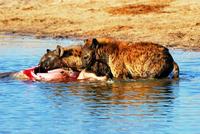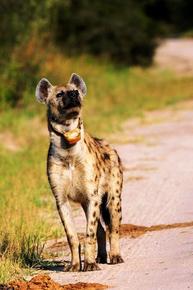Stéphanie Périquet
Last update: 9 August 2017
Summary
The main goal of this project is to provide sound data to better understand how hyaenas and lions can coexist in the same area.
We will determine the extent of competition for food and habitat between these 2 species that will help taking management decision for the conservations of large carnivores in Africa. This will also help to understand why hyaenas, lions and other large carnivore go out of protected areas where they get into conflicts with local communities.
Top carnivores determine biodiversity of an ecosystem through herbivore predation but also through interacting with sympatric carnivore populations. Carnivores are also a source of tourism and trophy hunting incomes and carnivore conservation can bring money to local communities. The conservation of such emblematic species is particularly important in Africa, where ungulates and carnivores diversity is particularly high.
Interspecific competition has been studied extensively for wild dogs and cheetahs versus lions, but very little is know on the extent of such a competition between the 2 top predators: lions and spotted hyenas. Spotted hyaenas have to cope with avoiding lions and staying close to them to gain access to food resources. In Hwange protected area, competition with lions have become more intense since lion trophy hunting had been banned since 2004. Male lions are doing particularly well and their presence at a carcass is assumed to prevent hyaenas to access it. Approximately 50 lions in Hwange National Park (HNP or Hwange hereafter) are already equipped with VHF, GPS or satellite collars (Hwange Lion Research, WildCRU, Oxford) and their ecology in this park is well known. These data can be used to better understand lion-hyaena interactions.
The aim of this PhD is to understand which mechanisms allow for coexistence between spotted hyaenas and lions in the wooded savannah of Hwange National Park.
Our main focus is to understand how lions and hyaenas can coexist when they are suppose to compete with each other quite intensively. To do this, we first need to get a better knowledge on hyaena ecology in wooded environment, as most of the previous studies have been conducted in the plains of East Africa or the desert of Southern Africa. This will be done thanks to GPS collars, behavioural observations, den survey and populations estimation. More GPS collars are to be deployed in 2012.
From there, we aim to untangle relationships between lions and hyaenas in HNP. The major requirement for this is to be able to get GPS data on the 2 species to study how they user their habitat (space and time) depending on the other. Data from these collars will give us information on lion and hyaena habitat selection (depending on prey availability, water sources…) to determine whether they avoid each other. We will also provide a detailed analysis of their diet to quantify the extent of their competition for food.
Furthermore, we need a better understanding of the interactions between large carnivores if we want to limit the impact of human-wildlife conflicts on their populations. Indeed, as large carnivores are more and more confined to protected area, competition is likely to increase and push them outside such areas, into communal areas where they prey on livestock.
Last update: 9 August 2017


